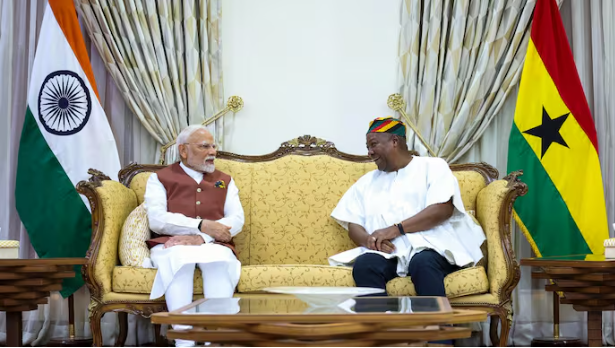Indian Prime Minister Narendra Modi last week paid a two-day working visit to Ghana as part of a five-nation tour.
During the visit, Prime Minister Modi addressed Parliament and indicated that India is ready to elevate its ties with Ghana to a comprehensive partnership.
Indeed, Mr. Dammu Ravi, Secretary (Economic Relations) at India’s Ministry of External Affairs (MEA) said an ambitious target of increasing bilateral trade from the current US$3billion to US$6billion over the next five years was agreed by the two leaders.
India is already among Ghana’s largest investors with over US$2billion in investments. There are roughly 900 active Indian companies operating in the country currently, while India’s concessional finance lines and grants also contribute significantly to Ghana’s economy.
During the visit, India and Ghana signed four key Memoranda of Understanding (MoUs) establishing a Joint commission and cooperation in traditional medicine, a cultural exchange programme and an agreement on standards.
Both countries see potential in expanding trade in pharmaceuticals, renewable energy and agriculture. In fact, President Mahama sought India’s support to position Ghana as a food basket in the sub-region.
President Mahama also invited India to bring its mining expertise and entrepreneurship to support sustainable exploration and value addition in the country. In addition, both leaders discussed practical models for Ghana’s 24-hour economy policy.
India’s experience of introducing shift-based operations in the health and education sectors can be viewed as a possible reference point for Ghana. India has indeed played a significant role both as a founding member and a leading force in the Non-Aligned Movement (NAM), and also emerged as one of the world’s largest economies.
India holds the 5th position among the world’s top economies, boasting a staggering chained real GDP of US$4.3 Trillion in 2025.
In 2006, Brazil, Russia, India and China created the “Bric” group. South Africa joined in 2010, making it “Brics”. The group was designed to bring together the world’s most important developing countries, to challenge the political and economic power of the wealthier nations of North America and Western Europe.
Egypt, Ethiopia, Iran, Saudi Arabia and the United Arab Emirates (UAE) were invited to become members with effect from 1 January 2024. The expanded group has a combined population of about 3.5 billion, or 45% of the world’s inhabitants.
With Iran, Saudi Arabia and UAE as members, Brics countries produce about 44% of the world’s crude oil.










